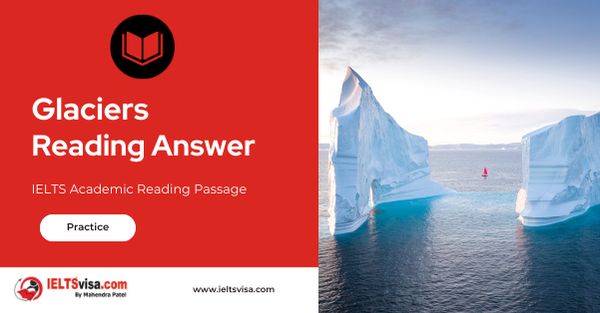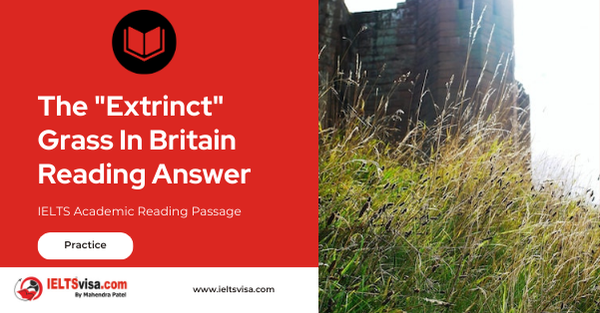Glaciers Reading Answer
IELTS Academic Reading Passage
A
Besides the earth’s oceans, glacier ice is the largest source of water on earth. A glacier is a massive stream or sheet of ice that moves underneath itself under the influence of gravity. Some glaciers travel down mountains or valleys, while others spread across a large expanse of land. Heavily glaciated regions such as Greenland and Antarctica are called continental glaciers. These two ice sheets encompass more than 95 percent of the earth’s glacial ice. The Greenland ice sheet is almost 10,000 feet thick in some areas, and the weight of this glacier is so heavy that much of the region has been depressed below sea level. Smaller glaciers that occur at higher elevations are called alpine or valley glaciers. Another way of classifying glaciers is in terms of their internal temperature. In temperate glaciers, the ice within the glacier is near its melting point. Polar glaciers, in contrast, always maintain temperatures far below melting.
B
The majority of the earth’s glaciers are located near the poles, though glaciers exist on all continents, including Africa and Oceania. The reason glaciers are generally formed in high alpine regions is that they require cold temperatures throughout the year. In these areas where there is little opportunity for summer ablation (loss of mass), snow changes to compacted fim and then crystallized ice. During periods in which melting and evaporation exceed the amount of snowfall, glaciers will retreat rather than progress. While glaciers rely heavily on snowfall, other climactic conditions including freezing rain, avalanches, and wind, contribute to their growth. One year of below average precipitation can stunt the growth of a glacier tremendously. With the rare exception of surging glaciers, a common glacier flows about 10 inches per day in the summer and 5 inches per day in the winter. The fastest glacial surge on record occurred in 1953, when the Kutiah Glacier in Pakistan grew more than 12 kilometers in three months.
C
The weight and pressure of ice accumulation causes glacier movement. Glaciers move out from under themselves, via plastic deformation and basal slippage. First, the internal flow of ice crystals begins to spread outward and downward from the thickened snow pack also known as the zone of accumulation. Next, the ice along the ground surface begins to slip in the same direction. Seasonal thawing at the base of the glacier helps to facilitate this slippage. The middle of a glacier moves faster than the sides and bottom because there is no rock to cause friction. The upper part of a glacier rides on the ice below. As a glacier moves it carves out a U-shaped valley similar to a riverbed, but with much steeper walls and a flatter bottom.
D
Besides the extraordinary rivers of ice, glacial erosion creates other unique physical features in the landscape such as horns, fjords, hanging valleys, and cirques. Most of these landforms do not become visible until after a glacier has receded. Many are created by moraines, which occur at the sides and front of a glacier. Moraines are formed when material is picked up along the way and deposited in a new location. When many alpine glaciers occur on the same mountain, these moraines can create a horn. The Matterhorn, in the Swiss Alps is one of the most famous horns. Fjords, which are very common in Norway, are coastal valleys that fill with ocean water during a glacial retreat. Hanging valleys occur when two or more glacial valleys intersect at varying elevations. It is common for waterfalls to connect the higher and lower hanging valleys, such as in Vosemite National Park. A cirque is a large bowlshaped valley that forms at the front of a glacier. Cirques often have a lip on their down slope that is deep enough to hold small lakes when the ice melts away.
E
Glacier movement and shape shifting typically occur over hundreds of years. While presently about 10 percent of the earth’s land is covered with glaciers, it is believed that during the last Ice Age glaciers covered approximately 32 percent of the earth’s surface. In the past century, most glaciers have been retreating rather than flowing forward. It is unknown whether this glacial activity is due to human impact or natural causes, but by studying glacier movement, and comparing climate and agricultural profiles over hundreds of years, glaciologists can begin to understand environmental issues such as global warming.
Questions 1-5
Reading Passage 1 has five paragraphs, A-E. Choose the most suitable heading for each paragraph from the list of headings below.
Write the appropriate numbers (i-viii) on your Answer Sheet
There are more headings than paragraphs, so you will not use them all.
1 Paragraph A
2 Paragraph B
3 Paragraph C
4 Paragraph D
5 Paragraph E
| List of Headings | |
| i | Glacial Continents |
| ii | Formation and Growth of Glaciers |
| iii | Glacial Movement |
| iv | Glaciers in the Last Ice Age |
| v | Glaciers Through the Years |
| vi | Types of Glaciers |
| vii | Glacial Effects on Landscape |
| viii | Glaciers in National Parks |
Questions 6-10
Do the following statements agree with the information in Passage 1 ? in boxes 6-10 on your Answer Sheet, write
TRUE if the statement is true according to the passage.
FALSE if the statement contradicts the passage.
NOT GIVEN if there is no information about this in the passage.
6 Glaciers exist only near the north and south poles.
7 Glaciers are formed by a combination of snow and other weather conditions.
8 Glaciers normally move at a rate of about 5 to 10 inches a day.
9 All parts of the glacier move at the same speed.
10 During the last Ice Age, average temperatures were much lower than they are now.
Questions 11-15
Match each definition below with the term it defines.
Write the letter of the term,A-H, on your Answer Sheet
There are more terms than definitions, so you will not use them all
|
Terms |
|
|
A |
fjord |
|
B |
alpine glacier |
|
C |
horn |
|
D |
polar glacier |
|
E |
temperate glacier |
|
F |
hanging valley |
|
G |
cirque |
|
H |
surging glacier |
11. a glacier formed on a mountain
12. a glacier with temperatures well below freezing
13. a glacier that moves very quickly
14. a glacial valley formed near the ocean
15. a glacial valley that looks like a bowl

Solution for: Glaciers Reading Answer
| 1. vi | 9. FALSE |
| 2. ii | 10. NOT GIVEN |
| 3. iii | 11. B |
| 4. vii | 12. D |
| 5. v | 13. H |
| 6. FALSE | 14. A |
| 7. TRUE | 15. G |
| 8. TRUE |
Review and Practice
- Regularly practice with IELTS reading samples and time yourself to get used to the pressure of the exam.
- Review your mistakes to understand where you went wrong and how to avoid similar errors in the future.
Our Books
Master IELTS Speaking Part 1
IELTS Writing Task 1 Book
IELTS Writing Task 2 Book
Glaciers Reading Answer Explanation
Comin Soon
Practice IELTS Other Modules
IELTS Listening
The IELTS Listening test assesses how well you can understand spoken English in various contexts. It lasts about 30 minutes and is divided into four sections with a total of 40 questions. The listening tasks become increasingly difficult as the test progresses.
IELTS Academic Reading
The IELTS Academic Reading section assesses your ability to understand and interpret a variety of texts in academic settings. It is designed to evaluate a range of reading skills, including skimming for gist, reading for main ideas, reading for detail, understanding inferences, and recognizing a writer's opinions and arguments.
IELTS Speaking
The IELTS Speaking test assesses your ability to communicate in English on everyday topics. It lasts 11-14 minutes and consists of three parts: introduction, cue card, and a discussion based on the cue card topic.
IELTS General Reading
IELTS General Reading tests your ability to understand and interpret various types of texts. Here are some key areas and types of content you can expect to encounter in the reading section, along with tips for effective preparation.
IELTS Academic Writing Task 1
In IELTS Academic Writing Task 1, you are presented with a visual representation of information, such as graphs, charts, tables, or diagrams, and you are required to summarize, compare, or explain the data in your own words.
IELTS General Writing Task 1
In IELTS General Writing Task 1, you are required to write a letter based on a given situation. The letter can be formal, semi-formal, or informal, depending on the prompt. Here’s a breakdown of the key components to include in your letter
IELTS Academic Writing Task 2
In IELTS Academic Writing Task 2, you are required to write an essay in response to a question or topic. Here’s a guide to help you understand the essential elements of this task
IELTS Exam Tips
To succeed in the IELTS exam, practice regularly, familiarize yourself with the test format, improve your vocabulary, develop time management skills, and take mock tests to build confidence.
Grammer for IELTS
Grammar is the foundation of effective communication in English. Understanding tense usage, subject-verb agreement, and sentence structure enhances clarity and coherence in writing and speaking.
Vocabulary for IELTS
Vocabulary plays a crucial role in the IELTS (International English Language Testing System) exam, especially in the Speaking and Writing sections. Here’s an overview of why vocabulary is important and how it impacts your performance
RECENT IELTS SAMPLES QUESTIONS AND ANSWERS
The Life And work Of Marie Curie Reading Answer
Marie Curie is probably the most famous woman scientist who has ever lived. Born Maria...
Becoming An Expert Reading Answer
A Expertise is commitment coupled with creativity. Specifically, it is the commitment of...
STUDY CENTRE COURSES Reading Answer
SELF-STUDY TIPS AHowever difficult you find it to arrange your time, it will pay off in the...
The Extrinct Grass In Britain Reading Answer
A The British grass interrupted brome was said to be extinct, just like the Dodo. Called...
Morse Code Reading Answer
A. A new satellite-based system is being implemented to replace Morse code for sending...
Magnetic Therapy Reading Answer
AMagnetic therapy, which is a $5-billion market worldwide, is a form of alternative medicine...













